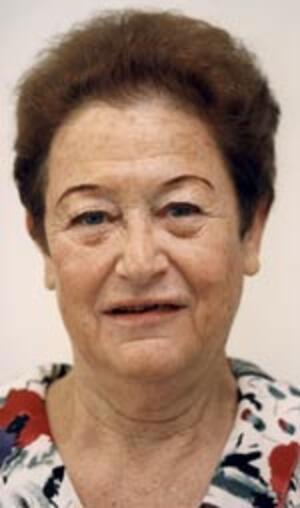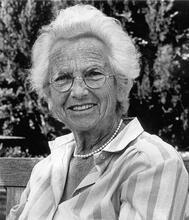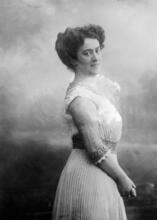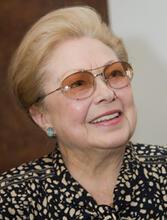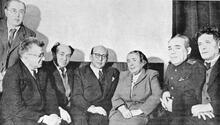Batsheva Bonne-Tamir
Batsheva Bonne-Tamir, of Tel Aviv University, was one of the first human population geneticists in Israel. For more than 50 years, she studied genetic markers and genetic diseases among the Samaritans and among other population groups in Israel. Between 1961 and 2004 she published 197 articles, held several prominent positions in local and international conferences, and served on the boards of many academic journals.
For more than 50 years, geneticist Batsheva Bonne-Tamir, from Tel-Aviv University, has studied genetic markers and genetic diseases among the Samaritans and other population groups in Israel. Between 1961 and 2004 she published 197 articles, held several prominent positions in local and international conferences, and served on the boards of many academic journals.
Family and Education
Batsheva Bonne was born in Jerusalem on July 27, 1932, to Theda (née Stein, 1901–1995) and Alfred (1899–1959) Bonne. Her parents met during their studies at Munich University and immigrated to Mandatory Palestine in 1925. Alfred Bonne was a professor of economics and dean of the faculty of social sciences at the Hebrew University of Jerusalem. Theda Bonne, who had studied gardening in Munich, was a homemaker. Batsheva was the third and youngest child; her sister Hava (b. 1925) received her doctorate in psychology and her brother Yochanan (1929–1987) completed a doctorate in water engineering.
When Bonne completed her high school education at the Hebrew Gymnasium of Rehaviah, Jerusalem, her father began a sabbatical year in Columbia University in New York, and young Batsheva traveled with her parents to New York. She took courses in English and art at Columbia University as well as a number of courses in biology at Stephens, a Women College in Missouri. A year later she returned to Israel to enlist in the Fighting Pioneer Youth unit of the Israel Defense Forces at A voluntary collective community, mainly agricultural, in which there is no private wealth and which is responsible for all the needs of its members and their families.Kibbutz Zorah, along with her friends from the youth movement. Her heart was torn between two passions: kibbutz life and academic education. Finally, she decided to leave the kibbutz and pursue the study of social sciences at the Hebrew University of Jerusalem. She also attended lectures on basic genetics taught by Elisheva Goldschmidt and wrote her bachelor’s thesis on marriage patterns among kibbutz members.
Graduate Work in Physical Anthropology
Bonne wished to continue her academic education in anthropology, but the discipline did not yet exist in Israel at that time. Awarded a full scholarship, she pursued her master’s degree in physical anthropology at the University of Chicago between 1958 and 1960. When by chance she found a book on the Samaritans, written by lsrael's second president Yitzhak Ben-Zvi, Bonne decided to focus her thesis on the Samaritans, a small, isolated ethnic group of a few hundred individuals divided into two parts living under different political allegiances. About 150 Samaritans lived in Holon, Israel, and 200 lived in Nablus, Jordan, near mount Gerizim, the group’s holiest site. Bonne studied the Samaritans' marriage patterns and found that over 40 percent of the marriages were between first cousins. Marriage of relatives was not only a necessity but was also perceived by the Samaritans as a biblical commandment. On a visit to Israel in the summer of 1961, Bonne presented her findings on the Samaritan community at the “The Genetics of Migrant and Isolate Populations” conference, organized by Elisheva Goldschmidt (1912-1970) and Chaim Sheba (1908–1971). This marked the start of a long and fruitful relationship with Sheba’s research team at Tel Hashomer hospital.
During the summer of 1961, Bonne collected blood samples from 90 of the 150 Samaritans who lived in Israel. She also studied the incidence of other specific genetically determined characteristics among those Samaritans, like deficiencies of the enzyme G6PD, taste sensitivity to PTC, and color blindness. The blood samples and other genetic data served as the basis for her doctorate under the advisorship of William Boyd, at the Boston University School of Medicine.
In the fall of 1963 Bonne visited Israel to get more blood samples, as well as anthropometric data (height, weight, and skull measurements) and morphological data on eye color, hair color, and fingerprint patterns. Bonne submitted her Ph.D. in June 1965; four months later she returned to Israel and joined the group of young researchers from Tel Hashomer who had founded the human genetics department at the Tel Aviv University School of Medicine the previous year.
Studying Genetic Diversity of Small Communities
Working with her colleagues in Tel-Aviv University and with a team of students, Bonne studied the genetic diversity of small communities (isolates). One of these isolates was the Habbanites, a small Jewish community of several hundred who arrived in Israel in 1950 from Hadramaut in Yemen. Bonne also studied a population of 9,000 Bedouin who lived in the southern Sinai desert. Those Bedouin were available to her as research subject after Israel occupied the Sinai desert in 1967, and the study was made possible thanks to practical help from the Israel Defense Forces. While conducting her research on the Bedouin in Sinai, Batsheva Bonne met her future husband, Zvi Tamir (1923–1996), who worked for the Israeli Intelligence and Security forces. Their son, Eldad Tamir, was born in 1970.
As a result of the six-day war in 1967, Nablus came under the control of the State of Israel. Bonne was eager to seize the opportunity to conduct research on the part of the Samaritan population that lived in the region, whom previously she could not reach, and discovered there cases of Usher syndrome. This rare recessive genetic disorder, which was not found among the Samaritans in Holon, is primarily characterized by deafness and accompanied by progressive loss of vision.
During the 1970s Bonne cooperated with Oxford University geneticists Lady Julia Bodmer (1934-2001) and her husband Sir Walter Bodmer (b. 1936), the world's leading experts in the HLA (human leukocyte antigen) system of genetic markers. HLA molecules are expressed on almost all our body cells, and they are the major molecules that initiate graft rejection. Bonne, together with the Bodmers, explored the distribution of HLA types among different populations in Israel: Libyan Jews; Ashkenazi Jews of German, Polish, Romanian, and Russian descent; Jews from Morocco, Iraq, Yemen, and Ethiopia; members of the Armenian community in Jerusalem; and Muslim Arabs. The research compared the eleven Israeli groups to nine non-Israeli population groups and used those genetic markers for calculating “genetic distances” between populations and as a vehicle for suggesting possible origins and histories of the studied populations.
From 1977 to 1982 Bonne chaired the human genetics department at Tel Aviv University. In 1979 she was promoted to associate professor and attained full professorship in 1987. During the 1980s Bonne cooperated with physicians and statistics experts in an effort to locate specific genes responsible for genetic diseases. Molecular methods enabled them to map the gene for Wilson’s liver and neurologic disease on chromosome no. 13; locate the gene for XIII factor, whose deficiency may cause bleeding episodes and lead to abortion in women, on chromosome no. 6; and the gene causing McArdle disease, a glycogen storage disorder, on chromosome no. 11. Usher syndrome, which was found by Bonne in the late 1960s among Samaritans in Nablus, was also located by the laboratory team on chromosome no. 11. During the 1990s, Avital Adato, Bonne's Ph.D. student, identified eight different mutations of Usher syndrome among various Israeli ethnic groups.
Beginning in the mid-1980s, studies of mitochondrial DNA became popular all over the world, as indexes of genetic maternal lines. In the following decade, Y chromosome tests were adopted worldwide as a tool for detecting paternal lines. It was important to Bonne to become familiar with the newest laboratory techniques. During her sabbatical year in Cavalli Sforza's laboratory at Stanford University in 1983–1984, she studied analysis of mitochondrial DNA samples and applied it to samples from Israeli Jews and Arabs. Bonne and her colleagues discovered similarities between mtDNA of Ashkenazi Jews and Jews from Morocco and revealed that the number of founding mothers of the Jewish population studied was smaller than the number of founding mothers of Arabs living in Israel. Later, in 2000, Bonne spend a few months in Michael Hammer's laboratory at the University of Arizona and took part in a research project that analyzed the Y chromosome among seven groups of Jewish men and sixteen groups of non-Jews. Their results indicate small distances between Jews and Mediterranean populations (PNAS 2000).
In 1992 Bonne was appointed the Near East representative in the Human Genome Diversity Project, which aims to collect genetic materials of different populations. In 1995 she established and headed, together with Mia Horwitz, the National Laboratory for the Genetics of Israeli Populations (NLGIP). This laboratory is a biobank for human cell lines, where frozen cell lines are preserved as a pool serving researchers from Israel and abroad. In 1997 the Yoran Institute for Human Genome Research was erected at Tel-Aviv University and the NLGIP became part of that institute. Bonne-Tamir was appointed to head the Yoran Institute and did so until her retirement in 2004. As a professor emerita, Batsheva Bonne-Tamir wrote an autobiography, Living with Genes: Fifty Years of Research on Genetics of Israeli Population. She passed away in April 8, 2020.
Selected Works by Batsheva Bonne-Tamir
Bonne-Tamir, B. Living with Genes: Fifty Years of Research on Genetics of Israeli Population. Jerusalem: Carmel, 2010 (in Hebrew).
Frydman, m. B. Bonné-Tamir, L. A. Farrer, P. M. Conneally, A. Magazanik, S. Ashbel and Z. Golwitch. "Assignment of the gene for Wilson disease to chromosome 13: linkage to the esterase D locus". PNAS - Proceedings of the National Academy of Sciences. 82 no.6 (1985): 1819-1821; https://doi.org/10.1073/pnas.82.6.1819
Hammer, M. F., A. J., Redd, E. T. Wood, M. R. Bonner, H. Jarjanazi, T. Karafet, S. Santachiara-Benerecetti, A. Oppenheim, M. A. Jobling, T. Jenkins, H. Ostrer and B. Bonne-Tamir. “Jewish and Middle Eastern non-Jewish populations share a common pool of Y-chromosome biallelic haplotypes”. PNAS - Proceedings of the National Academy of Sciences, 97, no. 12 (2000): 6769–6774. https://doi.org/10.1073/pnas.100115997

